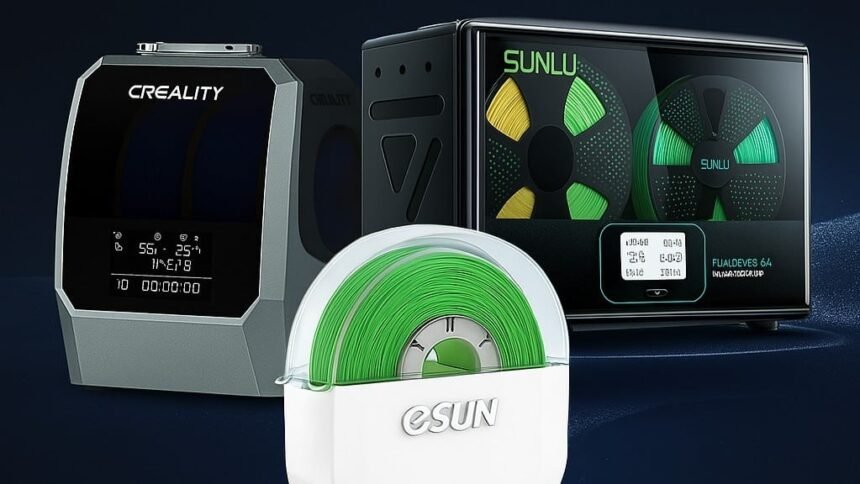The demand for 3D printing is increasing due to the infinite possibilities it offers us both individually and professionally. Filament storage has become a topic of concern because moisture is now ruining prints, and people are wasting a significant amount of money on them.
We are now in the age of Smart Filament Dryers, which incorporate a new set of devices that combine precise temperature control, real-time humidity monitoring, and even voice-controlled features for an easy drying experience.
In this blog, we’re covering what innovative filament dryers are, why they are better than our regular dryers, and how innovative features can change the way you manage your filaments.
What Makes a Filament Smart?
Unlike traditional filament drying methods, which rely on manual control and basic heating mechanisms, innovative filament dryers incorporate sensors for both heat and humidity control. Newer models are also equipped with connectivity features, allowing you to view everything on your mobile device while being voice-controlled as well.
Here are some of the features that make a filament smart.
-
Humidity Controlling and Triggering Sensors
Controlling humidity is the sole purpose of using a filament. However, with a humidity controller and triggering sensors, your filaments can always be in tip-top condition. For example, many filaments would dry at a specific temperature.
When you have a hygrometer built in, you can understand when to stop the drying process. This is one of the best features in a filament like the Chitu Systems FilaPartner E1. On the other hand, some filament dryers are triggered when the humidity reaches a certain level.
Both of these features are ideal for when you want to dry your filaments effectively.
-
App-Based Control
Some modern filaments also include the ability to connect to Wi-FI or Bluetooth so you can control every aspect of your filament dryer. One of the most common technologies being used in the filament drying community is the Tuya Smart. With Tuya Smart, you can:
- View real-time humidity and temperature data on your phone.
- Schedule drying sessions for your filaments.
- Set rules to auto-start or restart.
- Receive alerts if the moisture level exceeds a specific limit.
This level of control provides transparency, which ultimately results in accurate prints over time. If you have many filaments to dry, then a bright filament that includes Tuya Smart would be ideal for you.
-
Custom Material Profiles
Different filament types will need different drying conditions. For example, Nylon will need to be dried at a higher temperature of 80°C for 6–8 hours. On the flip side, PLA plus is a bit milder, so it will require 50°C for 4 hours.
Smart Dryers can come pre-loaded or allow users to make custom profiles for these specific drying conditions. This way, you won’t have to manually adjust everything every time, and the flexibility ensures that you are saving lots of time.
-
Power Loss Recovery
Many places around the world have power loss issues, and it’s not uncommon for electricity to go out momentarily in many areas. That’s where the power of some smart filament dryers comes in. Many modern filament dryers have memory-based recovery systems that will resume operation at the last saved state when the power is cut off.
Some of these filaments also come with an auto-restart that is triggered by the humidity sensor, creating a reliable drying setup.
Trends To Look Out for in 2026
While there are going to be many innovative features in filament dryers in the upcoming years, here are some features that are already hitting the market and can be deemed as essential in 2026:
Dual-Spool Support
Some premium filament dryers have dual compartments with separate humidity and heating sensors. This is also the case with Chitu Systems’ FilaPartner E1, where you can put two spools in one chamber with two total chambers. This ensures that you can dry two pairs of your spools at different temperatures.
This helps massively with multi-color printing, where you must use multiple filaments to make things happen.
Touchscreen Surfaces
Gone are the days when we used to operate with buttons. Smart dryers nowadays are coming with intuitive displays that show status and can be controlled using a capacitive screen. From timers, humidity, to controlling the temperature overall, these screens are ideal for when you’re drying a filament.
Over time, these screens will also be replaced with OLED ones, making the screen look much better and saving you some extra energy too.
Safety Protection
Safety is one big aspect that is going to make filament dryers better than other drying methods, like the DIY ones or drying with overs. For example, if the chamber is removed during the operations, the PTC will cut off heating to protect you and prevent the loss of energy.
Moreover, sometimes, overheating can worsen your filaments and ultimately destroy them. However, with smart filament dryers, you won’t be facing this issue because at high temperature, the heating will stop, and when the temperature is normal, it will reconnect.
The trends of Filament Dryers will continue to evolve. Soon, we will integrate AI into the process, allowing us to ask more challenging questions, such as the ideal temperature to dry a specific filament for a desired print. Or, maybe we can ask the AI about what to do when the nozzle is clogging. Having a personal assistant built into your dryer might be the future of filament drying.
Final Verdict
Filament Drying is a tricky subject. However, once you have everything under control and are ready to embrace these trends, the future may be efficient for you. If you want more products, visit Chitu Systems and their massive catalog of high-quality 3D printing accessories.







